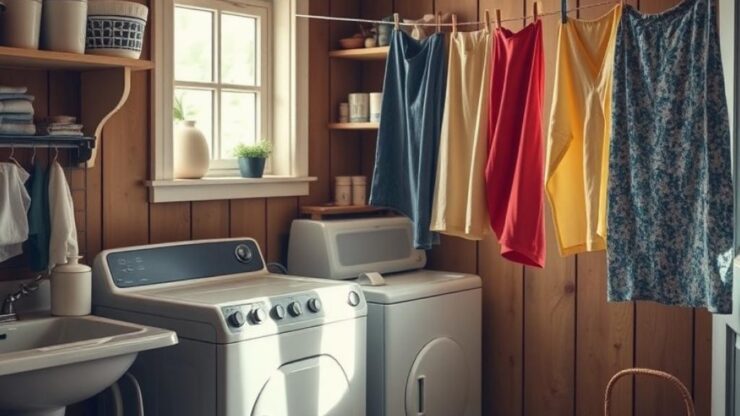Optimizing Water Usage in Laundry

Every household produces a significant volume of laundry, contributing to both water usage and utility bills. Knowing how to optimize water consumption during laundry can lead not only to financial savings but also to a more sustainable household. By evaluating the water footprint, you can implement strategies that minimize water waste while maintaining cleanliness and efficiency.
Implementing smart practices can drastically reduce the amount of water used in your laundry routine. Adopting these habits not only supports your budget but also contributes to environmental preservation. Here are some effective strategies:
- Wash Full Loads: Always aim to wash full loads of laundry. This maximizes water efficiency per item washed.
- Select Appropriate Settings: Use the correct water level setting for your laundry load size. Many modern machines offer options that adjust water usage based on the load.
- Use Cold Water: Opt for cold water washes whenever possible. This not only saves energy but also requires less water for heating.
- Short Cycles: Choose shorter wash cycles for lightly soiled clothes to decrease water usage.
- Regular Maintenance: Ensure your washing machine is in good working order to prevent leaks and inefficiencies.
By adopting these water-saving strategies, you can assess the long-term impact on your utility bills. To illustrate the potential savings from optimizing water usage, consider the following table that compares traditional washing habits with optimized practices:
| Washing Method | Water Used (Gallons) | Cost Per Load ($) | Annual Cost ($) |
|---|---|---|---|
| Traditional (Full Load, Warm Water) | 40 | 1.50 | 195 |
| Optimized (Full Load, Cold Water) | 30 | 1.00 | 130 |
By shifting to optimized practices, you could save approximately $65 annually, highlighting the financial benefits of mindful water usage.
Choosing Cost-Effective Detergents
In the quest to create a frugal laundry routine, selecting the right detergent plays a crucial role in both cost and effectiveness. Many consumers often overlook the impact of their detergent choices on overall laundry expenses. By understanding the various options available and making informed decisions, you can significantly cut down on your laundry costs while maintaining the cleanliness of your garments.
When evaluating cost-effective detergents, it’s essential to consider both price and performance. Some brands may lure consumers with low prices, but their efficacy might not justify the savings. On the other hand, premium detergents, while more expensive upfront, could prove to be more economical in the long run due to their concentrated formulas that require less product per load. This means that while the initial investment may be higher, the need for less detergent can lead to substantial savings over time.
Additionally, consumers should investigate eco-friendly detergent options that not only save money but also contribute positively to the environment. Many of these alternatives are designed to be biodegradable and free from harsh chemicals, making them safer for both your family and the planet. Although they may be priced similarly to conventional detergents, the benefits they offer in terms of gentleness on fabrics and skin can be invaluable.
It’s also wise to pay attention to bulk purchasing opportunities. Buying in larger quantities can often reduce the cost per load significantly. Many retailers offer promotions for bulk purchases, which can lead to additional savings. However, be sure to check the shelf life and storage requirements of the detergent to ensure that you buy an amount that will be used effectively without going to waste.
Energy-Efficient Drying Techniques

In the quest for a more economical and eco-friendly laundry routine, the drying process is often overlooked. However, adopting energy-efficient drying techniques can substantially reduce utility bills and environmental impact. As households strive to balance cleanliness with financial sensibility, understanding the various methods available for drying laundry can lead to significant savings. This section delves into effective strategies that not only conserve energy but also ensure that your clothes are dried efficiently and effectively.
One of the simplest and most effective ways to save energy while drying laundry is through air drying. Utilizing a clothesline or drying rack not only eliminates the need for a dryer but also helps preserve the integrity of your garments. Air drying allows fabrics to maintain their shape and color better than traditional dryer methods. Furthermore, hanging clothes outside can provide a natural scent and freshness that no dryer can replicate.
When air drying, consider the climate and season. In warmer months, outdoor drying is ideal, while in cooler months, indoor drying racks can be strategically placed near heat sources to facilitate faster drying. It’s essential to be mindful of moisture levels in your home to prevent mold and mildew. Thus, choosing the right location is crucial for an effective air-drying experience.
For those who prefer the convenience of a dryer, modern machines often come equipped with a range of energy-saving features designed to optimize drying performance. For instance, many dryers offer moisture sensors that detect when clothing is dry and automatically shut off the machine. This prevents over-drying, which not only saves energy but also extends the life of your fabrics.
Another notable feature is the eco mode, which uses lower heat settings and longer drying times to reduce energy consumption. This method is particularly beneficial for delicate items that require gentler drying conditions. By taking advantage of these features, you can achieve effective drying results while minimizing energy usage.
| Drying Method | Energy Consumption (kWh) | Cost Per Load ($) |
|---|---|---|
| Air Drying | 0 | 0 |
| Standard Dryer Usage | 3.0 | 0.45 |
| Eco Mode Dryer | 1.5 | 0.22 |
The table above demonstrates the stark contrast in energy consumption and costs associated with different drying methods. By opting for air drying or leveraging energy-efficient dryer settings, households can experience notable cost savings over time.
Incorporating these energy-efficient drying techniques into your laundry routine not only aids in reducing expenses but also contributes positively to environmental sustainability. Whether choosing to air dry or optimize dryer usage, each method reflects a commitment to responsible household management.
Maximizing Load Capacity for Savings
One of the pivotal factors in achieving significant savings on laundry expenses is maximizing load capacity. When households effectively manage the size of each washing and drying load, they can not only save on water and energy costs but also extend the lifespan of their garments. Understanding how to strike the perfect balance between load size and cleanliness is key to building a frugal laundry routine.
To truly grasp the impact of load capacity, it’s essential to consider the cost dynamics associated with washing and drying. Each time a machine runs, it consumes resources, such as water and energy, which directly correlate to your utility bills. By ensuring that washing machines and dryers are loaded appropriately, you can significantly decrease the number of cycles needed per week.
Determining the optimal load size is not merely a question of cramming as much as possible into the machine; rather, it’s about understanding the balance between efficiency and effectiveness. Overloading the machine can lead to inadequate cleaning, causing the need for additional cycles and ultimately negating the intended savings. Therefore, aim to fill your washing machine to about three-quarters of its capacity for maximum efficiency. This level allows the water and detergent to circulate freely, providing a thorough clean while minimizing resource usage.
Additionally, it’s vital to consider the types of items being washed together. Washing bulky items, such as towels or blankets, should be done separately to avoid overloading. Not only does this ensure that all items receive adequate cleaning, but it also prevents excessive wear and tear on both the fabrics and the machine itself.
In evaluating the financial benefits of optimized load capacity, it’s instructive to compare traditional laundry practices with more conscientious methods. The following table illustrates the potential savings realized through maximized load capacity:
| Washing Method | Water Used (Gallons) | Energy Used (kWh) | Cost Per Load ($) |
|---|---|---|---|
| Traditional (Underloaded) | 30 | 2.5 | 0.75 |
| Optimized (Full Load) | 20 | 1.5 | 0.45 |
This comparison highlights that by simply adjusting load capacities, households can decrease water consumption by one-third and energy usage by 40%, resulting in a cost savings of 30% per load. Over time, these savings accumulate, making a substantial difference in annual laundry expenses. Therefore, adopting a mindset focused on maximizing load capacity not only promotes better environmental practices but also aligns perfectly with a frugal lifestyle.
Maintaining Your Washing Machine for Longevity
In the quest for frugal laundry habits, maintaining your washing machine is crucial for maximizing efficiency and longevity. A well-cared-for machine not only performs better but also consumes less water and energy, aligning perfectly with your goal of reducing laundry expenses. By incorporating routine maintenance into your laundry practices, you can prevent costly repairs and replacements down the line.
One effective strategy to safeguard the integrity of your washing machine is to frequently clean the drum and detergent dispenser. Over time, residue can build up, leading to unpleasant odors and inefficient washing. Regularly running a hot water cycle with a cup of vinegar can dissolve buildup and keep your machine fresh. Additionally, it’s essential to check and clean the filter and drain pump periodically. Clogs in these areas can not only hinder performance but may also lead to potential leaks and expensive repairs.
Another vital aspect of maintenance involves monitoring the hoses connecting your washing machine to the water supply. Over time, hoses can wear or develop leaks, which can result in water damage and increased utility bills. Inspect these hoses for signs of wear and replace them every three to five years as a precaution. Keeping an eye on the condition of your washing machine’s components is a proactive measure that saves you from unforeseen expenses.
In addition to routine maintenance, your usage habits significantly influence your washing machine’s lifespan and efficiency. Always ensure that you load the machine correctly—overloading can strain the motor and cause wear and tear on the internal parts, while underloading wastes water and energy. Moreover, using the appropriate wash settings for different fabric types not only optimizes cleaning but also minimizes the strain on your appliance.
Lastly, consider the placement of your washing machine. Ensure it is on a level surface to prevent unnecessary vibrations that can lead to mechanical issues. By combining these thoughtful maintenance practices with mindful usage habits, you can enhance the longevity of your washing machine, ultimately contributing to a more frugal and sustainable laundry routine.
Disclaimer
This article has been created or edited with the support of artificial intelligence and is for informational purposes only. The information provided should not be considered investment advice. Please seek the support of a professional advisor before making any investment decisions.






